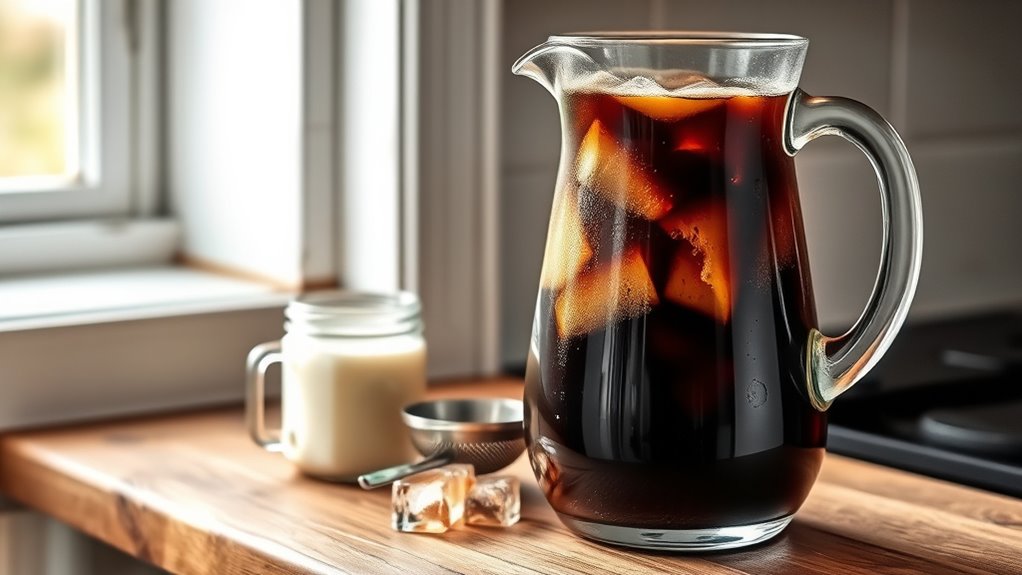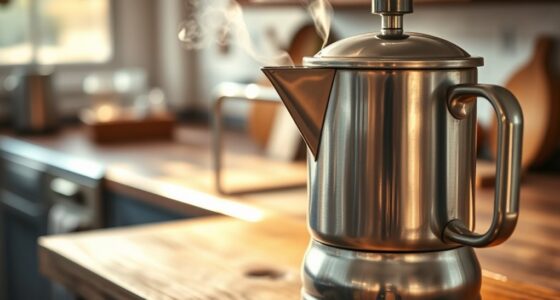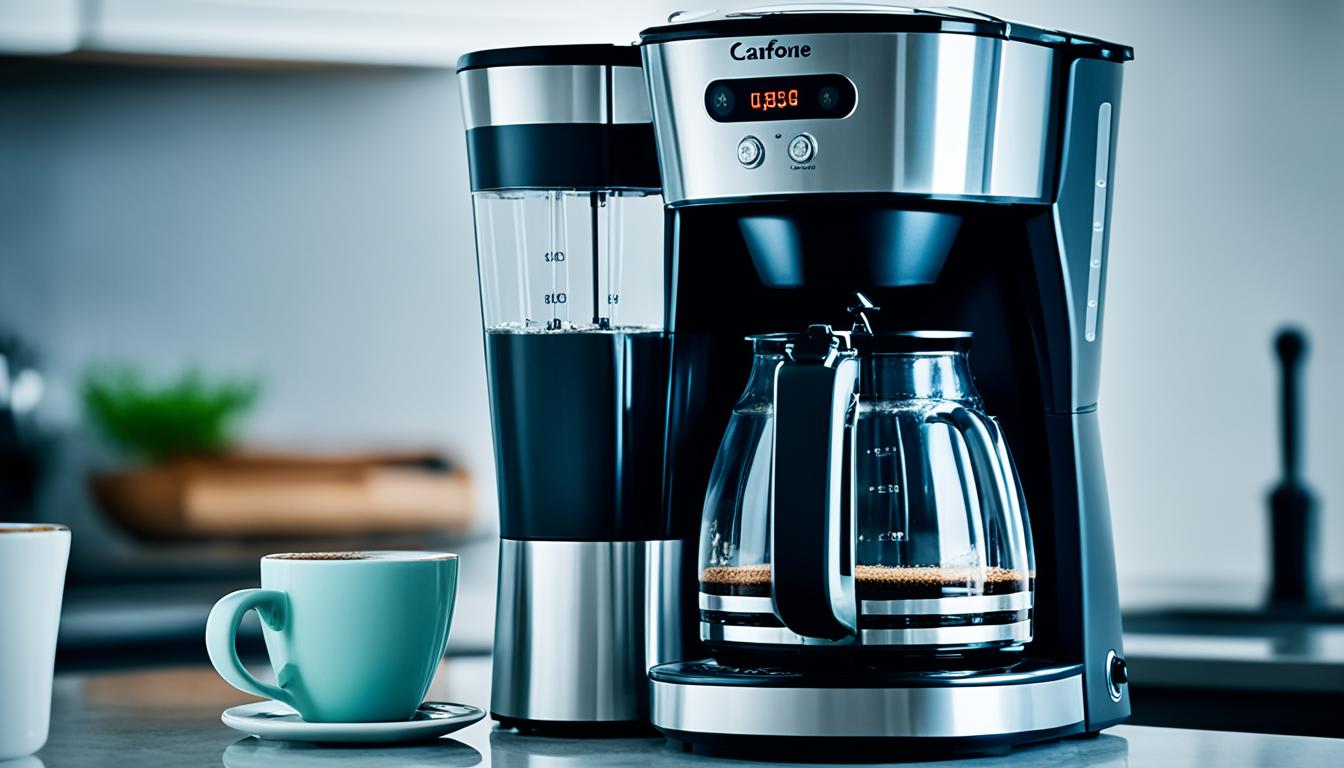To make cold brew at home, start with high-quality, whole beans and grind them to a coarse consistency. Combine 1 cup of coffee with 4 cups of cold, filtered water in a jar or pitcher. Stir gently, cover, and steep in the fridge for 12-24 hours. Strain out the grounds with a fine-mesh sieve or French press, then store your brew in the fridge. For detailed tips and variations, continuing will help you perfect your cold brew.
Key Takeaways
- Use high-quality, whole beans and grind to a coarse consistency for optimal flavor and extraction.
- Mix 1 cup of coffee grounds with 4 cups of cold, filtered water in a jar or pitcher.
- Steep the mixture at room temperature or in the fridge for 12-24 hours, stirring gently before steeping.
- Strain the coffee using a fine-mesh sieve, nut milk bag, or French press to remove grounds.
- Serve over ice, dilute if desired, and store in the fridge for up to two weeks for fresh, flavorful cold brew.

Making cold brew at home is a simple way to enjoy smooth, rich coffee without needing fancy equipment or barista skills. The key to achieving a delicious batch starts with your coffee bean selection. Opt for high-quality, fresh beans—preferably whole beans rather than pre-ground coffee. Beans with a medium to dark roast tend to produce a bolder, more flavorful cold brew, but feel free to experiment with lighter roasts if you prefer a milder taste. When selecting your beans, consider your flavor preferences: fruity, chocolatey, or nutty profiles all come through differently depending on the roast and origin. Grind your beans to a coarse consistency, similar to breadcrumbs, to ensure excellent extraction without over-extracting and resulting in bitterness.
Choose fresh, high-quality beans and experiment with roasts for the perfect cold brew.
Next, choosing the right brewing equipment makes a significant difference. You don’t need fancy gadgets—just a large jar, pitcher, or dedicated cold brew maker will do. Many people use a simple French press or a large mason jar fitted with a lid. If you want a cleaner, less sediment-heavy brew, a fine-mesh sieve or a nut milk bag can be handy for straining. The process begins with adding your ground coffee to your chosen container, typically a ratio of 1 cup of coffee to 4 cups of water, though you can adjust based on your strength preference. Pour cold, filtered water over the grounds, making sure they’re fully submerged.
Once combined, stir gently to ensure all grounds are saturated, then cover your container with a lid or plastic wrap. Let the mixture steep at room temperature or in the fridge for about 12 to 24 hours. Longer steeping yields a more concentrated brew, so plan accordingly. During this time, the coffee grounds slowly release their flavors into the water, resulting in a smooth, less acidic beverage. Proper steeping time allows for optimal flavor extraction without bitterness. Additionally, keep in mind that steeping duration can be adjusted to influence the final taste profile, with longer times producing stronger, more robust flavors. When brewing is complete, strain out the grounds using your preferred method. If you used a fine-mesh sieve, pour the liquid into a clean bottle or jar for storage. If you used a French press, simply press down the plunger and pour.
Finally, serve your cold brew over ice, dilute it with milk or water if desired, and enjoy. With a bit of attention to your coffee bean choice and proper brewing equipment, you’ll create a rich, flavorful cold brew that rivals your favorite coffee shop—all from the comfort of your home.
Frequently Asked Questions
How Long Can Cold Brew Be Stored Safely?
You can typically store cold brew for up to two weeks in the refrigerator. Keep it in a sealed container to minimize spoilage risks. After this period, the flavor may degrade, and bacteria could develop, increasing spoilage risks. Always smell and taste your cold brew before drinking if it’s been stored longer than a week. Proper storage helps maintain its freshness and safety, ensuring you enjoy your cold brew at its best.
Can I Use Flavored Coffee Grounds for Cold Brew?
You can use flavored coffee grounds for cold brew, but keep in mind that the flavors may become more muted during brewing. Flavored coffee works with various brewing methods, including cold brew, but it’s best to use high-quality, freshly ground beans for the strongest taste. Experiment with different flavors to find your favorite, and always store your coffee grounds properly to preserve their aroma and flavor.
What’s the Best Type of Coffee for Cold Brew?
You should choose coffee bean varieties with rich, smooth flavors like medium or dark roasts for cold brew, as they produce a bold, balanced taste. Opt for a coarse grind size, similar to sea salt, to prevent over-extraction and guarantee a smooth brew. Your preference for certain flavors and grind size will help you find the perfect cold brew, so experiment with different beans and grind settings to suit your taste.
How Do I Make Cold Brew Less Bitter?
To make your cold brew less bitter, you can try sweetening options like adding a touch of honey or cream to balance the flavors. Brewing adjustments also help—use coarser coffee grounds and shorten the steeping time slightly to prevent over-extraction. These tweaks will smooth out the bitterness, giving you a richer, more enjoyable cold brew experience. Experiment until you find the perfect balance for your taste.
Is Cold Brew More Caffeinated Than Hot Brewed Coffee?
Think of caffeine content as the heartbeat of your coffee; it varies with brewing strength. Cold brew tends to be more caffeinated than hot brewed coffee because it’s often brewed longer, extracting more caffeine. If you prefer a milder wake-up call, adjust the coffee-to-water ratio or brewing time. Remember, the strength of your brew directly influences how much caffeine you get—so choose your method based on your energy needs.
Conclusion
Now that you know how simple it is to make cold brew at home, you might wonder if it truly tastes better than store-bought. notably, some studies suggest that cold brewing’s lower acidity can improve digestion and reduce bitterness, making it gentler on your stomach. So, not only do you get a fresher, customizable coffee, but you might also enjoy health benefits. Give it a try—your perfect cup might just be a brew away!









